What is FOGO? The FOGO waste system has already started for most households, except for multi-unit developments. If your household is FOGO-ready, you are now able to place food organics and other compostable items into the lime-green lid bin, along with your garden waste. The contents of your FOGO bin will be turned into compost, instead of being taken to landfill.
The less we send to landfill, the better for our environment. Right now, up to half the contents of our red lid general waste bin is organic material that ends up in landfill. Under the FOGO system, we can divert this material from landfill and turn it into compost.
The WA State Government requires all local governments in Perth and Peel to move to FOGO by 2025. The City's early adoption of FOGO is part of our ongoing commitment to reduce waste and reduce greenhouse gases.
We have delivered the kitchen caddies to households, to help you separate food waste in your kitchen.
FOGO collections commenced on the following dates:
- If you live in Area 1 FOGO collections have commenced in the week beginning 12 April 2021
- If you live in Area 2 FOGO collections have commenced in the week beginning 22 March 2021.
You can use the interactive map on this page to find out if you are in Area 1 or Area 2.
Your FOGO bin (lime-green lid) is collected weekly, and your general waste bin (red lid) is collected fortnightly. Your bin sizes and bin day remain the same
To help ensure a smooth transition for everyone, your caddy includes all there is to know about FOGO: two rolls of compostable caddy liners as well as information, tips, stickers and fridge magnets.
To use your caddy, insert a provided compostable liner and start putting your kitchen scraps in there - vegetable peel, meat scraps, eggshells and the like. When full, tie the ends and place the bag in your lime-green lid kerbside bin for weekly collection on your normal bin day.
If you already have a kerbside collection with wheelie bins, you will move to FOGO from March 2021. This includes single houses and grouped dwellings or villas, sporting clubs, community groups, and businesses.
If you live in a multi-unit development like a townhouse, apartment or unit with a shared onsite bulk bin collection, your FOGO service will start at a later date. The City will contact strata managers and caretakers of multi-unit developments to assess their waste management requirements and work with them on a case-by-case basis to provide a FOGO service.
Phase 1 Commencing from March 2021 | Phase 2 Date to be confirmed |
Residents, groups and businesses who currently have a kerbside collection with wheelie bins. Includes: - single houses
- grouped dwellings or villas (with kerbside bins)
- sporting clubs
- community groups and
- businesses.
| Residents with a shared onsite bulk bin collection. Includes: residents in multi-unit developments such as townhouses, apartments or units (with shared onsite bulk bin collection). |
No, your collection day will stay the same. After you receive your kitchen caddy and start sorting your food waste, place your lime-green lid FOGO bin out every week. Your red lid general waste bin and yellow lid recycling bin will be collected fortnightly on alternate weeks.
- FOGO bin (lime-green lid bin): weekly
- General waste bin (red lid bin): fortnightly
- Recycling bin (yellow lid bin): fortnightly.
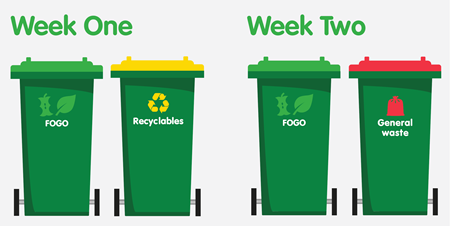
Click to find out when your bin collection day is.
No. During the transition to FOGO all three of your kerbside bins will stay the same size - 240 Litres.
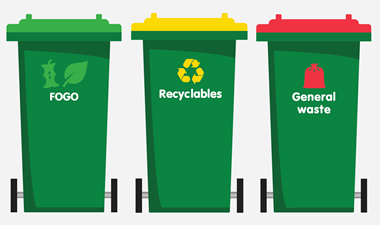
To request rubbish bin repair or replacement, please contact us on 9272 0605 or email waste@bayswater.wa.gov.au If emailing, be sure to include: the street address (of the bin service), your phone number, which bin you would like repaired or replaced, and why (is it broken, missing etc.).
There will be a cost of approximately $10 per household per year for FOGO collection and processing. This charge will first be included in your waste service fee on your 2021-22 rates notice.
No. The State Government requires all councils and residents in the Perth and Peel regions to adopt the FOGO waste system by 2025. Our early adoption of FOGO from March 2021 is part of our ongoing commitment to reduce waste and greenhouse gases. We will provide plenty of support and information to all residents ahead of our start date to ensure a smooth transition. If you have special circumstances, please contact us on 9272 0964 or fogo@bayswater.wa.gov.au
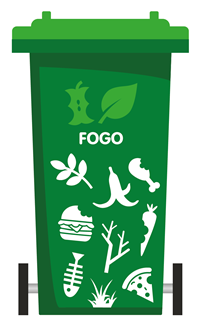 | These items are acceptable in your FOGO bin: All food organics including: - Vegetable and fruit scraps
- Meat and bones
- Seafood
- Eggshells
- Teabags and coffee grinds
- Dairy products
- Take away food (no containers).
Garden waste: - Grass clippings
- Pruning, cuttings, trimmings
- Twigs and sticks
- Palm fronds
- Weeds.
Other compostable items, including: - Animal droppings
- Kitty litter
- Hair
- Paper products with food oil on them (e.g. pizza boxes)
- Tissues, paper towel and shredded paper.
Find out more about what you can place in your kerbside bins. |
Everything that you put in your FOGO bin will be composted, so if it won’t rot or decompose it shouldn’t go in. If it didn’t live or grow, it’s not FOGO.
Please don’t put these items in your FOGO lime-green lid bin:
- Products you currently put in your yellow lid recycling bin
- Plastic bags (bread bags, shopping bags or garbage bags)
- Plastic packaging (bubble wrap)
- Nappies
- Personal hygiene products
- Treated and painted timber
- Building products
- Metals
- Glass
- Plastic plant pots, garden hoses, seedling trays or garden tools - the only 'garden products' that can go in, are things grown in the garden (green waste/garden organics)
- Textiles (e.g. old clothing or cloth nappies).
Find out more about what you can and can't place in your kerbside bins.
Your lime-green lid FOGO bin will be emptied weekly. The organic waste will be taken to Red Hill Waste Management Facility for processing into compost. The better you sort your food waste in the kitchen, the better the quality of the resulting compost. Remember no glass, metal or plastics in your FOGO bin as this will contaminate the compost. Only use the compostable bags provided by the City in your caddy, or line it with newspaper.
The compost produced from the contents of your FOGO bins can be used back in our community, sold to farmers and industry, or for rehabilitating land.
The potential uses for the compost will depend on its final quality, so it's important to separate your waste as well as possible and keep plastic, glass and metal out of the FOGO bin. Any non-organic items will contaminate the compost and affect the quality of the final product.
Our FOGO material, along with FOGO from SMRC councils, has been developed into a bagged Brunnings product through GO Organics.
Residents can purchase a Brunnings bag of compost from Bunnings, Mitre 10 and some IGA’s. We understand the community would love to access the compost they’ve contributed to making, and the long term aim will be for it to be available directly to residents in future. We don’t have details on when and how at this stage but it’s certainly something that we’ll be working with EMRC on.
Moving to FOGO will help reduce greenhouse gas emissions and save valuable space in landfill. When sent to landfill, organic waste breaks down in an oxygen-free environment and produces a harmful greenhouse gas called methane. Methane is 25 times more harmful as a greenhouse gas than carbon dioxide.
Under the FOGO system, food organics, garden organics and other compostable items are collected from households and processed in an oxygenated environment, which produces far less methane. The result is compost that allows the nutrients from your waste to be returned to the earth.
You can continue to use your compost bin, bokashi bin or worm farm. You can use your FOGO bin for items you can’t put in your home compost bin such as bones, meat and seafood. If you use bokashi, you can put the material from the bokashi bin into the FOGO bin after it has composted (if you have nowhere to bury it).
You are still able to use your lime-green lid kerbside bin for garden waste, along with food waste, which will continue to be useful for residents with gardens.
A free kitchen caddy, compostable caddy liners and instructions were delivered to each eligible household from March 2021 (see 'Who will get a FOGO service?' above, to find out if this includes your household). The caddy is a counter-top style bin with a lid and handle, to keep on your kitchen bench for collecting your food scraps.
If you move into a property and there is no kitchen caddy or liners there, please visit any City of Bayswater library where you can be issued a free kitchen caddy. Please bring identification with your address shown when coming to collect.
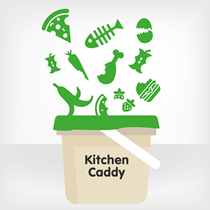
To use your caddy, insert a provided compostable liner and start collecting your kitchen scraps inside - vegetable peels, meat scraps, eggshells etc. After 2-3 days, or once the liner is full, tie a knot in the top to seal it and transfer the liner and its contents into your FOGO kerbside bin (lime-green lid). Put out the FOGO bin for weekly collection on your normal bin day. Visit this page to find out what day your bin is collected each week.
Using a compostable liner will reduce the need to wash the caddy. You can also line your caddy with newspaper as this will break down in the composting process. You can continue to put garden waste into the lime-green lid kerbside bin, along with your food waste.
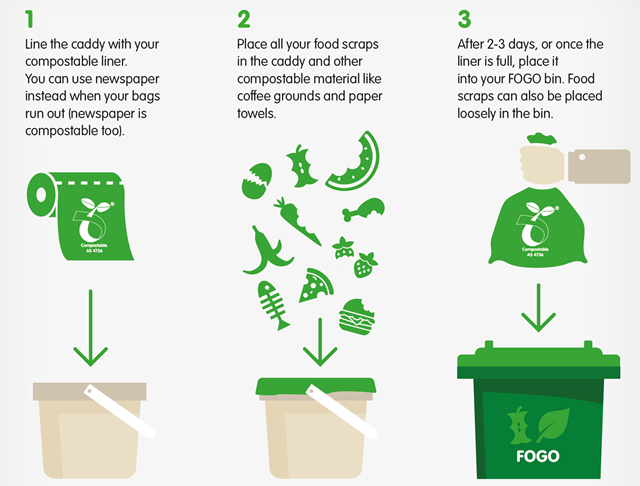
The caddy comes with an initial supply of two rolls of compostable liners (150 liners), which should last up to a year. The City will continue to provide an allocation of liners for residents annually. Additional liners will also be available for businesses, sporting clubs, community associations and schools participating in the FOGO system.
From 19 July 2021, you can collect more liners from a City of Bayswater Library, or our City of Bayswater Civic Centre at 61 Broun Avenue, Morley. When you come to collect, please bring identification that shows you are a City of Bayswater resident, i.e. something showing your address, such as a driver's license or utilities bill.
The allocation will be 2 x rolls of 75 liners (total of 150 liners) per waste year, per residence free of charge. Residents will be able to collect one roll at a time. The waste year runs from April 1 to March 31.
You can also purchase more compostable liners from supermarkets and hardware stores if you choose. Please look for this symbol (below) on the packaging, it indicates the product is certified compostable under Australian Standards and will break down during the composting process, without leaving any toxic residue which could affect plants and earthworms.
As an alternative, you can line your caddy with newspaper or a paper bag, as paper will break down in the composting process along with your FOGO waste. You can also place your food waste loose into the caddy and the FOGO bin - simply rinse out your kitchen caddy after emptying.
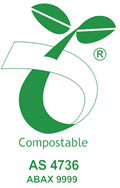
If you do use up your liner allocation before the end of the waste year, you can now purchase additional rolls from our facilities. Each roll costs $6 and contains 75 liners and there's a purchase limit of two rolls per collection
Can I collect both allocated rolls at once?
No, only one roll will be available for collection at a time. We recommend picking up your replacement roll of liners when you are near the end of your current roll, as the compostable liners have only a short shelf life and will begin to break down if stored for long periods.
How can I make the liners last longer?
We recommend changing the liner every 2-3 days, as they will begin to break down.
Heat and moisture can make them decompose faster, so we recommend storing your liners in a cool, dry place and soaking up any liquids from food scraps by placing paper towel or newspaper inside the compostable liner or at the bottom of the kitchen caddy.
Can I use the council supplied liners for pet waste?
The compostable liners provided by the City are intended to be used for food waste only. You can purchase certified compostable liners designed for pet waste from local pet stores, supermarkets or online retailers.
The yellow dog poo bags provided in City parks are certified compostable and can be placed in the FOGO bin. Alternatively, you can wrap pet waste in newspaper or place it loose into the FOGO bin.
No. Plastic bags, including degradable and biodegradable bags, will contaminate the FOGO bin. These products are not compostable - they are essentially plastics that have the ability to decompose faster than the traditional plastic bag. They eventually break down into microplastics, which are very small pieces of plastic that pollute the environment.
Instead, place only bags marked as 'certified compostable' with the symbol shown below, in your lime-green lid FOGO bin. Or as an alternative, you can place food waste directly into the FOGO bin, or use paper towel or newspaper to line your kitchen caddy or to wrap food waste.

Tips to reduce smells and insects:
- Use the compostable caddy liners, or wrap your food scraps in newspaper before placing in the kerbside bin
- Store bins in the shade or out of direct sunlight
- Put your FOGO bin out for collection every week, even if it's not full
- Put layers of dry materials such as lawn clippings and shredded paper in between layers of kitchen waste to absorb any smell
- Keep food scraps that tend to smell, such as fish bones, wrapped in newspaper in the freezer, until the night before bin collection
- Clean your bin with hot soapy water
- Sprinkle baking soda, kitty litter (unused), vinegar or clove oil into the bottom of the bin (when empty).
No. Nappies, continence pads and menstrual pads should be placed in your red lid general waste bin only (this includes both disposable and reusable nappies).
There are some simple measures you can take to minimise odour:
- If possible, tip the contents of the nappy down the toilet before disposing
- Wrap the nappy into itself using the tabs
- Seal nappies tightly in plastic bags (you may try double bagging or using scented bags if you wish) before placing in the general waste bin
- Store your red lid general waste bin in the shade and out of direct sunlight if possible
- Make sure your general waste bin lid closes properly and there are no cracks in the bin sides. If your bin is broken or cracked, please contact the City to request a repair or replacement
- You may consider using general odour neutralizing products in your red lid bin, including cat litter, crystals or bicarbonate of soda
- Place some odour neutralising products in the foot of a stocking and hang it on the inside of the red lid bin, tying the stocking to the bin lid handle
- Consider using modern cloth nappies or reusable pads and menstrual cups. For more information on modern cloth nappies visit Clean Cloth Nappies or the Australian Nappy Association. For information on the Cloth Nappy rebate that we offer, visit Cloth Nappy Rebate
FOGO liners can be collected by a nominated person on your behalf, upon providing a letter of authorisation requesting the City of Bayswater to issue the FOGO liners for your property to the nominated person. Please follow the instructions outlined in this form.